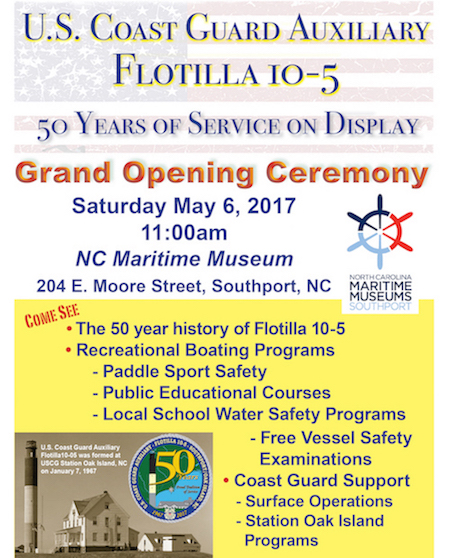Return to Flotilla 10-5's Home Page.
by 10-5 Historian Carol Urgola
PDF of Flotilla 10-5 Historical Highlights (2018)
U.S. Coast Guard Auxiliary Flotilla 10-5 was formed on January 7, 1967 at Station Oak Island/Southport, NC.
LCDR Joseph C. Fox, USCG, Marine Safety Officer and Captain of the Port of Wilmington, initiated efforts for an Auxiliary in the area. He said that the service was embarrassed by the lack of one in view of the many area Coast Guard installations. Also instrumental in this effort were Auxiliarist Alban Papineau of Plymouth, NC and Ace Childress of Elizabeth City, Director of Auxiliary. Col. William O. Beasley, from Oak Island, led the effort to establish Flotilla 10-05 in Southport, NC, which was officially chartered on January 7, 1967. (see The State Port Pilot article below). Flotillas were organized in Wilmington, Southport, Moorhead City and then added to the existing flotillas in Elizabeth City and Plymouth to create the new Coastal Carolina Division 10. Alban Papineau was the first Division Captain in 1966.
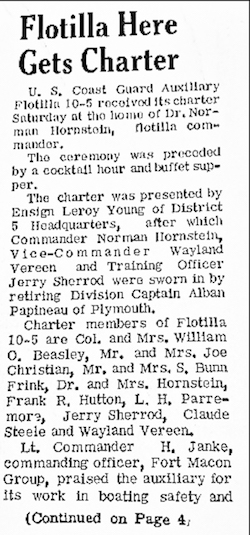
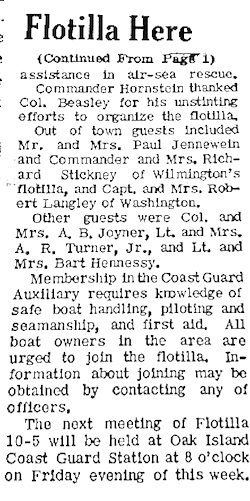
Col. William O. Beasley, from Oak Island, led the effort to establish Flotilla 10-05 in Southport, NC, which was officially chartered on January 7, 1967. Flotillas were organized in Wilmington, Southport, Moorhead City and then added to the existing flotillas in Elizabeth City and Plymouth to create the new Coastal Carolina Division 10. Alban Papineau was the first Division Captain in 1966.
Flotilla 10-05’s first official meeting took place at Coast Guard Station Oak Island on January 16, 1967. Flotilla Commander Dr. Norman Hornstein presided, with the assistance of Wayland Vereen, Vice Commander and Training Officer Jerry Sherrod. Joseph Christian was the first to become qualified in a program area with the help of Auxiliarists from Wilmington. He and Jerry Sherrod then trained more 10-05 members as Vessel Examiners. Charles Trott was the first new member after the Charter and was sworn in at the first official meeting.
In 1968, Col. William O. Beasley, from 10-05 became the Division Captain and BMC G.M. Vallender was the Officer in Charge of Station Oak Island. Safety patrols were conducted and Courtesy Marine Examinations’s were encouraged by the Coast Guard. The 95’ patrol boat Upright was stationed at CG Station Oak Island until 1969. Frank Hutton, Flotilla Commander and Robert D. Dixon , Vice Flotilla Commander, “were prepared to take whatever steps necessary to call to the attention of the proper authorities the vital necessity of having the 95’ craft remain on duty in the area.” They organized a meeting of local boatmen to discuss the issue. State senator Alton Lennon responded and explained the reasons for the move. The Upright was moved to Station Wrightsville Beach, NC in 1969.
In 1969, Governor Robert Scott declared June 29 – July 5 to be National Safe Boating Week. Flotilla 10-05 was on its way to bring the boating safety message to the area boaters, while supporting CG Station Oak Island.
The 1970 decade
In February of 1973, Frank Hutton, Flotilla Commander and Ed Christman, Vice Commander, of Flotilla 10-05, met with Coast Guard personnel from Ft. Macon, a representative from N.C. Wildlife and Capt. Hodges, Director of Auxiliary for 5th District to outline coordination of efforts and new duties for the Auxiliary. The foremost responsibility was the education of the part-time boater. They also outlined duties for safety patrols, including answering calls for assistance. Flotilla 10-05 consisted of eleven members.
1975 was a very busy year for the flotilla. Recruiting picked up with the addition of 8 new members. The instructors were teaching two Boating Skills and Seamanship classes a year at the old Sacred Heart Rectory on the corner of Caswell and West. The week of June 27th was declared National Safe Boating Week by Mayor Thomlinson of Southport. Merritt Lear was the head of the National Safe Boating Week committee that year. He worked with representatives of the other services, NC Wildlife and Marine Mart to encourage boating courses and Courtesy Marine Exams during the 4th of July festivities. They also had a CME booth at the Small Boat Harbor on July 3rd and 5th.
A very successful Division meeting was hosted by 10-05 in July 1975 at the Long Beach Town Hall for 40 officers and members. It was followed by a fish fry at Middleton Park, which was attended by 100 people. The next morning, they started with breakfast and then eleven boats and their crews went to their assigned locations to begin to begin checking aids to navigation at the request of the National Ocean Survey Organization. After the conclusion of the cruise, all returned to debrief and write their reports. By 3 PM, the charting cruise was completed and visiting members were on their way home in boats, trailers and cars. The Division Meeting/Fish Fry/Charting Cruise was repeated in 1978 and was a great success.
In 1977, Flotilla 10-05 received Fifth District Awards for top hours in Member Training, Patrols, Chart Updating, and total hours activity. Ed Christman was Flotilla Commander.
Flotilla 10-08 Shallotte was chartered on 3 Nov 1979 with 10 members from 10-05. Jack Campbell, recent FC of 10-05, became the new Flotilla Commander of 10-08.
Flotilla 10-05 rounded out the 1970 decade with boating courses twice a year, CME’s year round and a very active program each year for National Safe Boating Week. Flotilla 10-05 and 10-08 members participation in the first King Mackerel Tournament in 1979, with public affairs materials and a communications booth, manned by members Jane Campbell and Louise Polka.
The 1980 decade
Flotilla 10-05 started out the 1980 decade with ten fewer members, due to the formation of Flotilla 10-08 in Shallotte in 1980. That meant that they had to work hard to recruit and train new members and get up to strength. The decade had a slow start with increasing membership, but things started to pick up in 1984 when an especially energetic Auxiliarist with a public relations background transferred into 10-05. James Flowers came from a large, active flotilla and when he got to 10-05 with its 15 members and 2 facilities, it was a shock. With intent to grow the flotilla, he started a public affairs campaign. Flowers was then elected Flotilla Commander in 1985 and 1986. Change was on its way.
The 1980’s was a very busy and interesting decade for Flotilla 10-05. The Public Education program was extremely strong with Boating Skills and Seamanship classes being taught 2 or 3 times a year. At the start of the decade, both meetings and classes were held at the Hood Building on Moore St., which the flotilla rented for $1 per year. Classes were well attended, but increased when the flotilla started advertising their classes through the Brunswick Technical Institute. In 1988, classes were moved to the Brunswick Community College building in Southport. The flotilla netted 11 new members from the 1988 classes, which increased the membership to 36. The cost of classes went from $9 to $10 by the end of the decade.
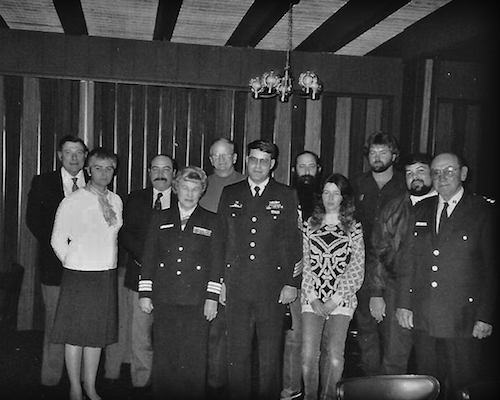
National Safe Boating Week was scheduled for the first full week in June during the 80’s. Vessel examiners numbered somewhere between 5 and 8 each year and they conducted Courtesy Marine Examinations from Holden Beach to Southport.
Operations was also in high gear, not only with routine safety patrols, but with special exercises with the Coast Guard. Boating access was established at Fish Factory Road by the N.C. Wildlife Commission in 1980, making that area very useful for training. In 1982, the flotilla had 9 qualified crew who conducted 650 man-hours on patrol. Land-based and mobile radios were employed during every patrol. Also in 1982, Vice Flotilla Commander George Zieres received the Life Saving Award, the highest operational award given to Auxiliarists by the Coast Guard. Rear Admiral John Costello presented the award to George for having saved the life of Howard Toney of Boiling Springs, NC. Mr. Toney later became a member of the flotilla.
In 1985 Flotilla membership stood at 21. With 6 qualified skippers, they completed 500 man-hours on patrol. Land based radios were utilized in Southport (Merritt Lear) and Long Beach (Jean St. Andre). They also assisted with the communications center for the King Mackeral Tournament and provided safety patrols as well. This was also the year that Merritt Lear donated his boat, the Mya Tina to Flotilla 10-05 in memory of Edward Christman, Flotilla Commander in 1977 and member for 13 years.
1986 brought Fleet Exercise II, which was a 7-day period of on water exercises at the Wilmington Waterfront. The Mya Tina was called into service with her crew, consisting of Vice Flotilla Commander Herb Green, Paul Smitz and Jean St. Andre. They had to be ready 24/7 to be called out at any time. And they did get called out at 2 AM! VFC Herb Green was also the first member of 10-05 to attain the AUXOP designation.
The next large operational event occurred in 1989: Operation Solid Shield. According to George Stern (member from 1987-2015), the Defense Zone exercise was the most memorable event that he had participated in as an Auxiliarist. This was an exercise by the Navy and Coast Guard to train in coast line defense against illegal immigration. George was one of a number of Auxiliarists who played the part of an illegal alien. They used the Mya Tina in some of these exercises. George was eventually “arrested” along with several other “illegals”. They were put in chains and displayed on the steps of the Court House in Wilmington. George said this caused quite a stir among those who didn’t know what was going on.
Other exciting events of the 80’s included helicopter training in 1987, a tour of the Lt. Jack Lummus ship at Sunny Point as guests of the U.S. Marine Corps, and Change of Command at Station Oak Island. The flotilla had grown from 15 members in 1984 to 36 in 1988: It was an era of teamwork and great leadership with Doug Otto, George Zeires, James Flowers, Jean St. Andre, Coy Hewitt as flotilla commanders.
In 1985, member Merritt Lear donated his 25 ft. Chris Craft, the Maya Tina, to the flotilla to be used for patrols and training. The only condition of the donation was that the name of the vessel should remain. It was named for his two granddaughters.
At the time, Auxiliary and Coast Guard rules prohibited the flotilla from owning a boat or receiving large cash donations. So Jim Flowers registered and incorporated a non-profit corporation called Flotilla 1005. Jim, Paul Sweeny and Floyd Henry were Directors of the corporation and members were all from the flotilla. The Corporation owned the boat, but “loaned” it to the flotilla for its use. The city of Southport donated a free dock in Old Harbor, but the boat could not leave the dock unless under Coast Guard orders, thus providing insurance coverage.
There was a problem of money to maintain the boat. So, in 1986, as Concession Chairman for the 4th of July celebration in Southport, Jim Flowers got the Corporation booth space to sell hot dogs and cotton candy. They bought a small office trailer and converted it into a food stand (in today’s parlance, a food truck!). Work on the trailer was accomplished quickly. The work crews rebuilt the entire inside. There was no Coast Guard identification displayed, as this was a non-profit Corporation project. Bob Maker took on the job of lining up work crews and scheduling members to work shifts on July 3rd and 4th. These were the big money making days.
Money raised was given to the flotilla as a donation to maintain the Maya Tina. It also made it possible to initially rebuild the engine, install dual radios, take care of annual maintenance, plus some other flotilla activities. Herb Greene took on the oversight of necessary purchases to bring the Maya Tina up to first class condition.
The Maya Tina participated in many patrols, training session and special events like the King Mackerel Tournament. Qualified crew and coxswains got a chance to train and run patrols but everyone was involved in maintaining the boat and raising money to keep her going. In 1989, the flotilla voted to spend $3,000 to buy a new engine and other materials needed to keep her sea worthy.
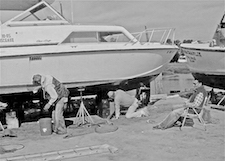
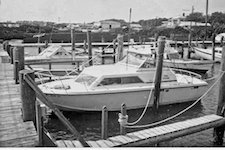
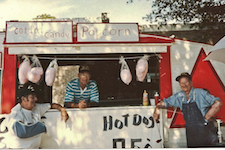
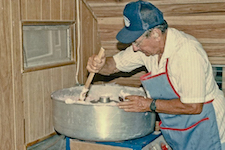
The Maya Tina earned the Outstanding Facility Operations Award for the 1990 patrol season and the Silver Award for Operations for the 1991 season.
The 1990 decade
In 1991, the question of the legality of the Corporation was brought to the attention of the flotilla. After some discussion with flotilla members, Flotilla Commander Susan Hancock authorized a committee to look into the legal requirements for the corporation and some new rulings coming down from the Coast Guard. In accordance with the Auxiliary manual, the Commandant had approved the organization of only one corporation to support the activities of the Auxiliary, and that was at the national level. Any flotilla corporation had to be dissolved. Flotilla1005 Corporation was officially dissolved on 12/31/91.
The plan was to have some members take ownership of the Maya Tina and offer it for use as an operational facility. Legal questions needed to be answered, so in 1992, the Maya Tina remained on her trailer until DIRAUX could make a determination on if or how they could use her as a facility. Evidently, the decision was made to allow ownership, because the Maya Tina was on patrol again in November 1992, after the water pump was replaced, transmission work done and a new long block installed.
At the beginning of the 1993 patrol season, the flotilla gave the Maya Tina new patrol signs and a new Ensign. The facility and her repairs were now supervised by the Chief Engineer at the CG Station. She ran a full patrol schedule from May to the end of July. The log book shows one patrol in May 1994 and one in May 1995, after which the Maya Tina returned to her berth at the Coast Guard Station.
The food stand continued to sell hot dogs, soda and cotton candy at the 4th of July celebration each year to support the facility as long as she was in use. It also appeared at several other festivals in the area. In fact in 1993, the Town of Long Beach requested the food stand for one Saturday a month from May until September.
The Maya Tina sank while at the small pier at Station Oak Island (exact date has yet to be documented). The members voted not to repair her and donated the vessel to the Coast Guard who raised it and transported it to Ft. Macon for boarding training. The money in the treasury was converted to a CD and the proceeds withdrawn annually to support flotilla activities. The money is still supporting the flotilla today.
The decade of the 90’s began with many changes for Station Oak Island and the members of 10-5. In January of 1990, the Coast Guard announced that plans for a new administration building and dormitory facility were about 30% complete. In June of 1990, Senior Chief Jeffrey Arndt became the new OIC and overseer of the project. In 1991, Susan Hancock was elected Flotilla Commander of 10-5, the only woman to hold that office in 50 years! Construction would begin in the fall of 1991. Boating classes were scheduled as usual, but were held at the Hood building on Moore St. Courtesy Marine Exams were held every weekend from 6 to 9 AM at the Wildlife boat ramp, and patrols and on-water training with the CG were scheduled. Even amidst the construction, it was business as usual, to the best of everyone’s ability. Chief Arndt issued a letter of appreciation to the flotilla for all the help they were providing, as well as the operational training for the active duty during that time. In May of 1992, the new station was open for business.
As the Auxiliary entered into its 6th decade, the Coast Guard, recognizing its value, began to integrate the Auxiliary into the everyday functioning of the service. The Coast Guard Auxiliary Act of 1996 expanded the Auxiliary purposes to assist in any Coast Guard mission as authorized by the Commandant, with the exclusion of law enforcement and military actions. Auxiliarists tended to and inspected lighthouses, patrolled federal, state and private aids to navigation, and helped the Coast Guard maintain them. They monitored the operation and off-loading of barges in harbors and marinas. Some small boat stations became manned in part or full by Auxiliarists.
In 1994. George Axon, with the help of Bert Felton, put together information about the Oak Island Lighthouse, the Coast Guard station and the vessels stationed there. At that time the lighthouse was still under the jurisdiction of the Coast Guard and considered part of the station. With the Chief’s permission and the information assembled, they began recruiting “tour guides.” Gene and Emma Bellflower were the first to volunteer. Most of the tour guides have been from 10-5, but several from 10-8 and 10-7 have also been a part of this program, which still exists as of this writing.
The decade of the 1990’s witnessed some of the largest call-outs for disaster in Coast Guard Auxiliary history: Hurricane Andrew in 1992, the 1993 great mid-western floods, the Cuban-Haitian airlift in 1994, on July 17, 1996, TWA flight 800 en route to Paris exploded in mid-air off Long Island, New York, and the 1997 devastating 15-foot flood waters of the Red River engulfed Grand Forks, North Dakota and surrounding region. In each instance Auxiliarists, and sometimes 100’s of Auxiliarists, were there to provide communications help, logistical support, filling in for active duty at small boat stations, ferrying utility crews, flying surveys of the areas affected, and assistance in search and rescue and anything the Coast Guard needed them to do.
North Carolina experienced several hurricanes in the 1990’s. In 1998, LCDR Haines, from Group Fort Macon presented the members of Division 10 with a Unit Citation for having skillfully executed the preparation for and subsequent recovery from the 1996 hurricanes Bertha and Fran. Bonnie (1998) and Dennis (1999) followed and the decade came to an end with hurricane Floyd, which created the “Flood of the Century” in North Carolina. And, again, members of 10-5 were there to assist.
Individual rescues were also highlighted in the 90’s. When BM2 Larry Dean, SN Karl Anderson and Auxiliarist Goeff Chaney were patrolling the Cape Fear River in the 44’ MLB after hurricane Bonnie, they were only checking for debris. While determining whether or not the river could be opened to traffic, they ended up saving a life. They heard a call for help and eventually found a blind and disoriented man in the water, clinging to a piling. They pulled him from the water, tended to his lacerations and treated him for shock before transferring him to local emergency medical services. Dean and Anderson each received a Commandant Letter of Commendation and Chaney was awarded the Auxiliary Award of Operational Merit. Well done!
The 2000 decade
The new 2000 decade began on a note of optimism. The Courtesy Marine Examinations (CME program was updated as the Vessel Safety Check (VSC) Program and the Auxiliary was partnering with the Power Squadron to increase the impact on recreational boating safety.
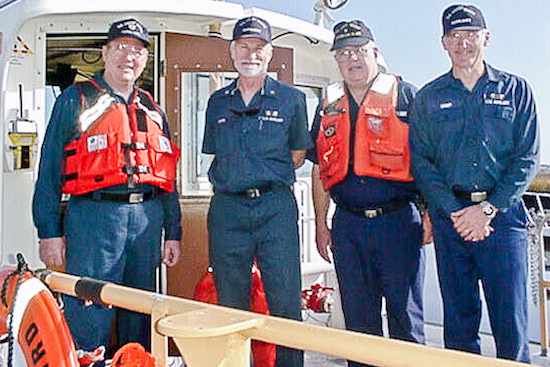
The members of Flotilla 10-5 were engaged in all the program areas, with 8 public education-classes planned, boat crew training at Fort Macon, and night navigation training.10-5 had a close relationship with Station Oak Island. On the Operations front, members were involved as watch standers at the station, cooks in the galley and crew members on the 41’ motor life boat (MLB).Chief Bradford used 10-5 Auxiliarists on the helm and on the watch.During the Change of Watch, Chief Cantrell replaced Chief Bradford. 10-5 was 50 members strong and Sam Cantanzaro and Bob Pavco were at the helm.
On July 14, 2001, the M/V Edward A. Carter, Jr. was being loaded with high explosives and ammunition at Military Ocean Terminal, Sunny Point, on the Cape Fear River, when a fire broke out in the engine room. While the Coast Guard proceeded to the location of the 950-foot container ship with the 41’ MLB and the 21’ RHI to search for a crewman who had jumped overboard, the Auxiliary established a safety zone that closed the Cape Fear River in the vicinity of the fire. In less than an hour more than 20 Auxiliarists were mustered to crew the facilities, stand radio watches, and assist with various other necessary activities throughout the night. Members of Flotilla 10-5 provided much needed support services to the Active Duty and Reserve assigned to the duty station.
10-5 Auxiliarist Frank Harrison, was a marine fire fighter throughout most of his career with the Coast Guard. After he retired from the Coast Guard, he became the Marine Fire Chief for the Port of Philadelphia. When he moved to Southport, Frank served as the Key Technical Advisor on Marine Fire Fighting for the Ports of Wilmington and Cape Fear. After the shipboard fire at Sunny Point, the Coast Guard realized they lacked the expertise in marine firefighting in this district. So they called on Frank, who trained many Sunny Point firemen, as well as Coast Guard firemen in the intricacies of fighting marine fires. In 2005, Auxiliarist Harrison publish the Manual Shipboard Fire, which was adopted for use by the Coast Guard. In 2009, Frank published an interesting 50 year memoir entitled Fire and Water. Frank Harrison passed away in 2016.
September 11, 2001 – Al Quaida terrorists high-jacked commercial airlines and attacked the World Trade Center in New York, the Pentagon in Washington, DC and one plane was crashed in Pennsylvania, resulting in 3,000 deaths. There was a nationwide call-out of the Auxiliary and 10-5 was ready to answer the call.
After 911, Chief Cantrell and the Captain of the Diligence asked Division 10, including 10-5, to patrol the Cape Fear River near the Diligence, maintain regular station patrol (now 7 days a week), watchstanders were needed 24/7, accompany night guards and walk the grounds, and assist with maintenance. Later, in 2002, the 911 Auxiliary Response Team would receive a Meritorious Team Commendation for their support of Station Oak Island.
Between the events of 911, heightened security, the transition in the hierarchy at the station, and the delivery of the new 47’ MLB, changes were made in the way 10-5 members were trained for operations. Additional training was required of the Active Duty and Reserve on the Coast Guard boats, especially the 47’ MLB, so the Auxiliary training time on the CG vessels was eliminated. Auxiliary training would be done while on patrol in an Auxiliary facility, which were now scheduled seven days a week. It was the trainees’ responsibility to make arrangement with the Coxswain for tasks they needed. Dockside training began again in November, 2001.
The February 6, 2002 – Station Oak Island Fire
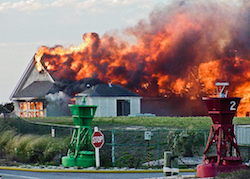
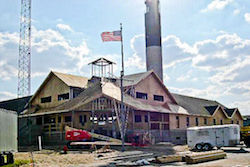
The Friday afternoon fire ravaged the CG Station in 30 minutes, with the help of a 35 mph southwest wind. Thankfully, there were no serious injuries. The cause was thought to be electrical.
Through perseverance, help from the community, Auxiliary and the Coast Guard, the station was able to get temporary quarters for the offices and communications center and housing for the six that lived at the station. Other CG units covered their area of responsibility until they were able to get back on line, just three days after the fire started.
In 2003, the U.S. Department of Homeland Security was formally established and included the USCG and the Auxiliary. Two-boat training was schedule for every Tuesday and Thursday and it was requested that 10-5 have a facility on stand-by every day, with the ability to be underway within 2 hours of the call-out. Members of 10-5 participated in Operation King’ Hat Trick, in support of Operation Noble Eagle, under the supervision of the Marine Safety Office, Wilmington. As a part of this operation, the MSO conducted innovative and intensive training using Auxiliarists to expedite qualifications of the Reservists assigned to execute new missions, as well as other activities to ensure the areas readiness and security. 10-5 members were also recognized for the successful use of the prototype Utility Boat Light. The objective of this operation was to evaluate the strategy of developing Auxiliary operated, CG owned and maintained vessel program as an effective Homeland Security force multiplier. In response to the sinking fishing vessel Della J, 10-5 members were recognized for meritorious service as part of the Carolina Beach Safety Inlet Zone Enforcement Team. Emphasis of all these high profile exercises was on readiness and security.
The highlight of 2004 was the reopening of the new Coast Guard Station. As always, the members of 10-5 were there to help, as well as celebrate the day. The Vice Admiral Thad Allen presided over the dedication ceremony. He also enjoyed taste-testing the BBQ cooked by John Frazier and his assistants, Jim Janovetz, Joe Boland and Jim Siedliski!
Operation Cape Fear took place in 2005, on the Cape Fear River by Auxiliary facilities and crew from Division 10, including members of 10-05. The purpose of this mission was to check the Locks for possible safe harbors for the Coast Guard facilities during hurricanes and major storms moving on shore from the ocean. The crews also checked for proper location of the mile markers, looked for pollution, possible hazardous material in the water and hazards to navigation on the river. They also looked for any area that could breach security zones. All tasked were accomplished and the mission successfully completed.
Fall 2005 brought fellowship to the beach. The beach party included friends, Frogmore Stew with a little wind and sand for flavor. A good time was had by all.
2005 also brought the Operational Dress Uniform, the Award of Operational Excellence for the Utility Boat crew, awarding of the USDOT 911 certificates and ribbons, the new Recreational Boating Safety (RBS) device, and Team Coordination Training and the FEMA courses (100, 700) became required for boat crews.
Then, on 29 August 2005, Hurricane Katrina arrived. Again, members of Flotilla 10-5 stepped up for the challenge. The Presidential Unit Citation, ribbon and “hurricane” device would be presented to the Coast Guard and the Auxiliary for their exceptional commitment, expertise and operational readiness during the aftermath of the storm.
Public Education, membership recruiting and keeping the UTL Operational Program active to meet the goal of 24/7 on-water security, highlighted the flotilla efforts in 2006. FSO-PE Jack Hisley conducted America’s Boating Course, Boating Skills and Seamanship, Navigation Course, and GPS for Mariners. These popular courses generated a good number of students, new members, and revenue for 10-5. To grow quality membership, 21 new individuals were enrolled in 2006. Socially, 10-05 was very active with an event at least every quarter: two barbecues, Frogmore Stew, and a cookout at the Station with family. Of course the Change of Watch (COW) was always well attended. At the COW, Chief Dawn Smith mentioned that she would like to have someone paint a mural on the training room wall. With the help of Joe Boland, FC, artist Dick Staat was solicited and agreed to paint the mural. After several weeks, the mural was done and it will be enjoyed for many, many years to come. 2006 also brought the inaugural Safety Day at Station Oak Island.
Jackson Lewis became 10-05’s first historian in 2006, and Joe Boland, FC also appointed a Historical Committee to gather data and documents to start the process. John Frazer (FSO-PB) re-started the “SPOTLIGHT” on new and long term members. These actions were the seeds for rebuilding our history for the 50th anniversary.
Nancy Hahn was awarded the CG Auxiliary Commendation Medal for her extensive volunteer service to the Coast Guard, including her work in reorganizing and redeveloping the Rescue and Survival Systems Program. She was also recognized for her involvement in a CG patrol that resulted in the rescue of three individuals who had been thrown from their boat.
On 3 February 2007, three Auxiliary OPFACS from 10-5 and 10-6 maneuvered as lead and trail safety zone screens to USCG Albacore, to escort M/V Zhen Hua 16, and her cargo of four new 100-foot container cranes, from off shore in the vicinity of Bald Head Island, through the mouth of the Cape Fear at Southport and then up the river to the State Port in Wilmington. Auxiliary air support was provided by Flotilla 20-6. The planned trip Zhen Hua was 5-7 hours from the buoy to the State Port, but start to finish the mission for the crews took 8 hours. Eight major organizations participated in the planning and execution of this mission. This was a good example of the application of our Team Coordination and Incident Command training.
Flotilla 10-5’s involvement in Marine Safety was highlighted in 2007 by the accomplishments of four of our members. Jim Stoddard, Bob Eldridge, Chris Halladay and Larry Coble, working for two years with the Marine Safety Unit in Wilmington, earned the distinction of Junior Officer of the Day and earned their Trident Device. At the time of the award, Flotilla 10-5 was the only flotilla in the USCG Auxiliary that had 4 Trident recipients. They work at the Marine Safety Office and continue to investigate new Marine Safety endeavors in Station Oak Island’s area of responsibility as well. The Flotilla was granted money in 2007 by BOAT US to create, install and maintain monofilament (fishing line) recycling bins at Southport Municipal Pier and, later, at Yaupon Pier and Ocean Crest Pier. The recycling bins were installed in March 2008.
In 2008, the Coast Guard Meritorious Team Commendation was presented to 23 members of Flotilla 10-5 as members of the Auxiliary Utility Boat Operations Team. They logged over 1800 hours prosecuting homeland security, and search and rescues. The Team diligently completed over 400 patrols that couldn’t be filled with active duty resources. The 16 coxswains and 40 crew members of the Boat Operations Team also provided area of familiarization and towing training to the active duty units that wouldn’t have otherwise been available. As a truly integrated component of the Coast Guard, the Team escorted the USCGC Eagle, as well as other invaluable Tall Ships in multiple high profile marine events.
2008 also brought about Modernization in the Coast Guard, creating Sectors and restructuring units under each Sector Commander. The Auxiliary also went under restructuring and many flotilla were either combined or eliminated. Flotilla 10-5, with its large number of active members and support of Station Oak Island was unchanged by the process. Crews completed 213 patrols, including the King Mackerel Tournament in October. The flotilla had outgrown the training space at the Station and moved its meetings to Southport Baptist Church and then to Trinity Methodist in 2009.
As the end of the decade rolled around, the Coast Guard and the community said goodbye to the Aids to Navigation Buoy Tender Blackberry. The 62 year old ship was decommissioned and its crew will soon staff the stations new cutter, Bayberry.
The AIMS notification system was put into use in 2009. Training, as always, was a big focus, but in 2009 Commercial Fishing Vessel Safety (CFVS), Search and Rescue and Mass Casualty Rescue Operation (MRO) training topped the list. Operation Safe Catch stressed commercial fishing safety; a two-day Search and Rescue exercise was conducted for Auxiliary crew at Wrightsville Beach. MOM patrols (Maritime Observation Mission) were conducted under the auspices of the Marine Safety Unit in Wilmington.
Senior Chief John A. Sesta, Officer in Charge of Station Oak Island presented Warren Edman with the Coast Guard Boat Force Operations insignia. Frank Egan previously received the Boat Forces insignia. Nancy Hahn passed her check ride and is now a fully qualified crew member on the CG 25’ response boat. Nanette Gabler passed her Captain’s License and is now beginning study on her Master’s License. Congratulations to Warren, Frank, Nancy and Nanette for their great accomplishments. They exemplify the spirit of 10-5 members to train, learn, apply and meet the challenge.
2009 saw the termination of the Loran-C system. And during this decade, Flotilla 10-5 lost
several long term members: Coy Hewitt, Rich Thomas, Stan Ash and Gerry
Marsh. Fair winds and following seas,
dear friends.
The 2010 decade
This decade saw several changes that would affect the way the Auxiliary conducted patrols. In February, 2010, the Coast Guard permanently terminated the transmission of all U.S. Loran-C signals. The Boat Crew Qualification Maintenance and Currency Program was changed to require at least 12 underway hours per year and a QE check every three years. Auxiliary Air Observers were required to meet the same medical screening requirements as the Air Crew. The Marine Safety Trident Program Qualifications were updated to require five years of sustained activity and support at the marine safety unit, instead of four. Guidance was issued on the use of cellphones and smart phone while on patrol. Preparation and performance were emphasized. Master Chief Cantrell authorized Auxiliary members to ride on the Coast Guard vessels as observers. Permission was granted based on the nature of the mission, space available and would initially start with training patrols.
In January of 2010, three past Flotilla Commanders, Warren Edman, Joe Mazzei and Bert Felton braved the frigid weather to assist in the Cold Stroke Classic Regatta. It was a frigid 23 degrees when they started the patrol on Jan.9th. The pre-race briefing took place at the Dockside Restaurant just south of the Wrightsville Beach Bridge. The paddlers were to race 3.5 miles or 7 miles, depending on their class. The 10-5 facility was assigned to follow the last wave of paddlers. A short time into the race a father and son were seen to be lagging behind. The father requested help from the patrol boat and asked to be taken to the EMS team on site for the race. The father and son were taken on board. Bert and Joe wrapped the boy in a blanket and Warren drove back to the Dockside where the passengers were attended to by the EMS team. This patrol provided a good lesson on hypothermia, which was shared with the flotilla.
2011 was highlighted by the arrival of the AUXCHEF program at Station Oak Island. Jim Stoddard, Larry Coble and Tony Rizzo received their AUXCHEF certification and began their support of the station galley personnel, cooking and serving breakfast and lunch.
In December 2011, Auxiliarist Nancy Hahn was recognized as the Station Oak Island Sailor of the Quarter for her contributions to the station and its crew. As an active member of the station’s Rescue and Survival Team, she devoted numerous hours to inspecting and maintaining the rescue and survival equipment. Auxiliarist Hahn is also the only member of Flotilla 10-5 to qualify as boat crew, with the active duty, on a Coast Guard vessel. Her devotion to her work in support of the Station Oak Island led to her nomination by her CG peers for the Sailor of the Quarter.
The Coast Guard Meritorious Team Commendation was received by a large number of Flotilla 10-5, as well as other flotillas, for exceptional service in support of Station Oak Island from December 2009 to December 2012. Due to Operation Deepwater Horizon, the Coast Guard redistributed some of its manpower and utilized the Auxiliary to fill some of those gaps. Station Oak Island was brought down to minimum crew level.
Members of 10-5 and other flotillas stepped forward to assist Station Oak Island in a number of ways. Auxiliary Radio Watchstanders were scheduled almost every day. On Wednesdays, a team of members met at the station to work on various projects such as painting, caulking, driveway sealer, volleyball court and whatever needed to be done to improve facility maintenance and operational excellence. In addition, the Auxiliary chart updating team began its work, preparing charts for Ready for Operations and Standardization Team Assessments; and the inspection of Rescue and Survival equipment was conducted, maintained and logged by an Auxiliarist as part of the R&S Team.
2013 ushered in an emphasis on leadership and teamwork. “Flotilla 10-5 is large: 100++ members, with enough capable appointed staff, coxswains, crew, facilities, instructors, inspectors, etc. to do what is needed. However, with resources and good fortune come responsibility and expectation. Individual energy and commitment alone are not enough for success. As a result, enhancing the overall structure and interactions of our flotilla has been an area of major focus for the leadership of 10-5. To maximize our potential we have this year restructured into functional teams: “RBS Prevention” Team, led by Pete Urgola, an “On The-Water” Team, led by Chris Halladay, and a “Public Outreach & Member Services” (POMS) Team led by Jack Gordon. The POMS Team is devoted to all those who take care of our membership and our partners in the public sector...without which the Flotilla could not operate. Rounding out the picture is a Leadership Team led by Dan Agopsowicz, FC and Butch Willette, VFC.
We are also uniquely fortunate to be sited at a very active and supportive Coast Guard Station...Station Oak Island, at Caswell Beach NC. We are there for meetings, as watch standers, to assist in OTW training, to chef, to update charts, to do maintenance...to be with them, our partners. BMSC Cantrell, BMC Jordan and BM3 Allen work with us daily in the most productive and professional fashion possible. Nothing drives home the reason for our AUX existence as much as the opportunity to serve in meaningful ways with the impressive Staff and Crew of Station Oak Island.” Quoted from the Commander’s Comments in the Loud Hailer April 2013.
Water n’ Kids program was initiated in 2013, with the first class at Southport Elementary and then at Safety Day. This program has been well supported by the members and well received in the schools. It continues to grow as our instructors travel to new schools each year. By 2016, we will have taught the Kindergarten, first and second grades in all 10 elementary schools in Brunswick County.
2014 rang in the 75th anniversary of the USCG Auxiliary. The flotilla’s teams continued to work, sharing ideas across disciplines and initiating new ideas for public outreach. Efforts were coordinated between Public Affairs, the Webmaster and the Facebook editor (new in 2014) to tell our story to our members, as well as the public. An official flotilla photographer was also established with 2 additional back-up photographers, to make sure we have a photographic record of all events. All of these officers also provide information to the Historian to complete the loop. A Speaker’s Bureau was initiated with visits to the Southport Rotary Club and Lions Club. Nine new Coastie operators were trained to support the public outreach going forward. Members participated in 10 public events in 2014 to bring the message of boating safety to the public, promote boating safety classes and vessel examinations. The energy of the Public Affairs program in 2013 continued on in 2014, resulting in National recognition of Flotilla 10-5’s Public Affairs program as the best PA program in the nation. National recognition was also received by Dawn Smith (National Photography Award), Irene Reynolds (Growth Award), Award and Cooperative Charting Awards went to the flotilla and the Century Club Awards were presented to many of the flotilla’s Vessel Examiners. And Rhonda Willette became 10-5’s first female Coxswain.
The Auxiliary Commandant Letter of Commendation award was presented to Chris Halladay for his service as the leader of the Station Oak Island Tour Guide Team from May 2013 to September 2014. Chris took on the responsibility of training the tour guides and scheduling the tours which took place every Wednesday from May through September each year. Twenty-three tour guides from three flotillas also received a Coast Guard Meritorious Team Commendation for their contributions to Station Oak Island.
Joseph Wheeler, John Askin, Charles Duke, Eric Palmer and James Griffith received a Coast Guard Meritorious Team Commendation for their accomplishments as a part of the Coast Guard Real Property Audit Auxiliary Photographic Team. Utilizing Auxiliary facilities and land-based vantage points, they photographed all of the Coast Guard’s federal aids to navigation in our area of responsibility. This was done to help the CG complete a physical inventory of real property assets and was a time critical project. Flotilla 10-5’s team completed 100% documentation in our area in advance of the deadline.
On January 4, 2015, a barge with a large crane was transiting the Atlantic Intracoastal Waterway and hit overhead power lines south of South Harbor Village Marina. This caused an extremely hazardous condition to the general boating public as the power lines were in the water. The Sector Commander closed the AICW in the vicinity of the downed wires and the Coast Guard and County Sheriff Marine Patrol secure the site for the remainder of the day. On January 5, 2015, Coxswain Warren Edman and his crew, Jim Griffith and Floyd McLeroy, were on scene at 0645 on the south side of the downed power lines, near the NC Wildlife ramp. Numerous vessels attempted to gain access to the area, but they were intercepted. They remained on station for 7.5 hours, until the wires were repaired and the Captain of the Port opened the AICW for public transit. The crew received special District recognition from District Commodore Sersen for securing the winter safety zone when power lines were down on the Intracostal.
2015 was a year of new ventures. Flotilla 10-5 added nine new members and two transfers, received a $2000 grant for Water & Kids, taught a Paddlesport course for the first time, offered an ABS class in Spanish and another for women only, arranged for newspaper reporters from various newspapers to write articles about their activities, enjoyed the new Frogmore Stew fellowship event, TV reporters came to a VE Ramp Day and produced an article about vessel safety, complete with photos of members performing a VSC. The Marine Safety program participated in a new environmental event at the Lockwood Folly River, and flotilla members collaborated with the Power Squadron to produce an article on boating safety for National Safe Boating Week.
In 2015, a sub-team was formed for the Public Education program, with the FSO-PE being responsible for the six ABS classes, one assistant responsible for BS&S and a second assistant responsible for the Water & Kids program for grades K, grades 1 and 2 at three elementary schools. That team approach enabled the flotilla to maintain the three existing PE programs without risking instructor burn-out, and allowed them time and resources to try some expansion into new areas of public education.
2015 was a year of growth in RBS. The Vessel Examination program increased their productivity by 82% and Partner Visitation by 30% over 2014, the Public Affairs program increased its scope to include several new venues for their boating safety messages, and the Public Education program added 2 new courses to its agenda. Operations personnel increased by 2 coxswain and one crew member. Flotilla 10-5 received the recognition from Division 10 for its outstanding RBS efforts in 2015.
2016 built upon the Recreational Boating Safety success of 2015. Dawn Smith, FSO-PE; David Tester, FSO-VE; Lee Garvin, FSO-PV, Glenn McVicker, FSO-PA and Bob Lewis our Facebook expert, continued in their positions and perfected the art of teamwork to make 2016 ‘The Year of RBS’. A Public Affairs strategy was planned within the team, combining existing public outreach methods with some new and exciting venues. TV reporters showed up at Safety Day, in the classrooms and on the ramps. Newspaper reporters were invited to do specific articles on vessel exams in action. Articles on the Auxiliary were written for local community magazines. Facebook was ramped up and social media began to take hold and became a source of information on classes, vessel exams and membership. The PA booth even appeared at the local movie theater for the showing of The Finest Hour. National Safe Boating Week activities were also increased with vessel examiners at five marinas conducting 97 VCSs in one weekend. Proclamations were signed in Southport, Oak Island, Caswell Beach and Boiling Springs Lakes.
The Partner Visitation Program is a combination of public education and public affairs. The flotilla is now up to 13 Partner Visitors who are well trained, knowledgeable members who conducted 520 visits, personally advocating our boating courses and encouraging vessel exams. This year partners have increased to 66!
Public Education classes showed a marked increase in number of students. 101 students graduated from seven ABS classes, 16 from the BS&S class (doubled from 2015) and 16 from the Paddlesport class (tripled from 2015). A special class was done for approximately 20 Boy Scouts. And finally, 1500 elementary school children learned about water and boating safety through the Water n’ Kids program.
Vessel Examinations had a very productive year due to the 2016 VE Challenge to be the #1 flotilla in Division 10 for VSCs. As of June 26th, the Vessel Examiners of 10-5 had completed 282 VSCs. The challenge was for each of the 16 Vessel Examiners to do one VSC per week for the rest of the year. As of this writing, they have performed 507 Vessel Safety checks, a 42% increase over 2015. The challenge also included maintaining their high quality examinations and education of the boating public. Numbers are great, but quality is best! In 2016, five new vessel examiners were added to the team and two vessel examiners earned the RBS Device. Congratulations to Lee Garvin and David Tester. We now have 7 vessel examiners in our flotilla with the RBS device. The effect of our RBS prevention programs on boater safety cannot be measured. The positive effect is every day we do not see a drowning or boating tragedy.
It has been a wonderful, productive 50 years for Flotilla 10-5!
It has been difficult, at best, to highlight Flotilla 10-5’s 50 years of service, when there are so many noteworthy individuals and missions. So many good people have joined Flotilla 10-5, trained hard and given of themselves and made significant contributions to further boating safety and support the Coast Guard.
To all members of Flotilla 10-5, past and present, we say: “Thank you all for you service!”
A Fifty-year celebration was held January 6, 2017.
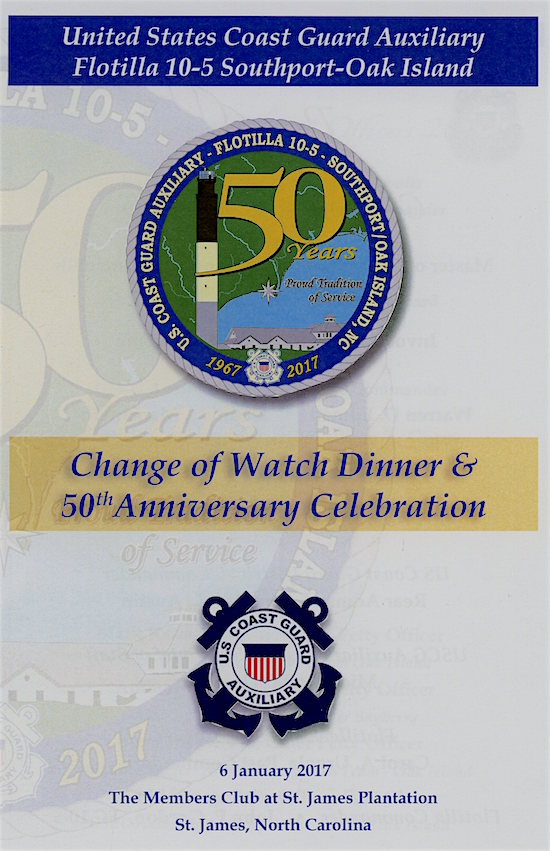
25,720 missions and almost 157,000 mission hours (2001-2016)
50 Year History Display at Southport Maritime Museum
